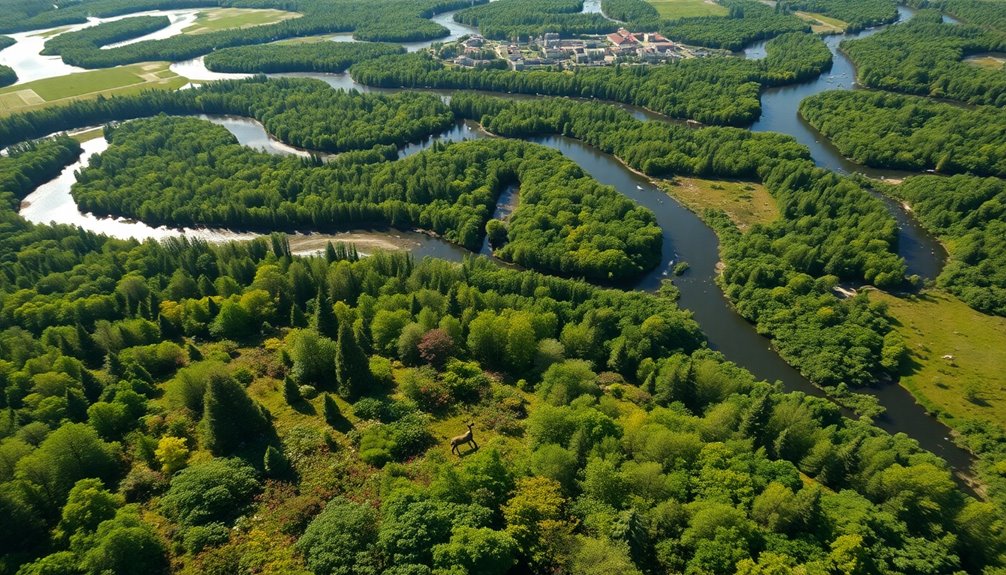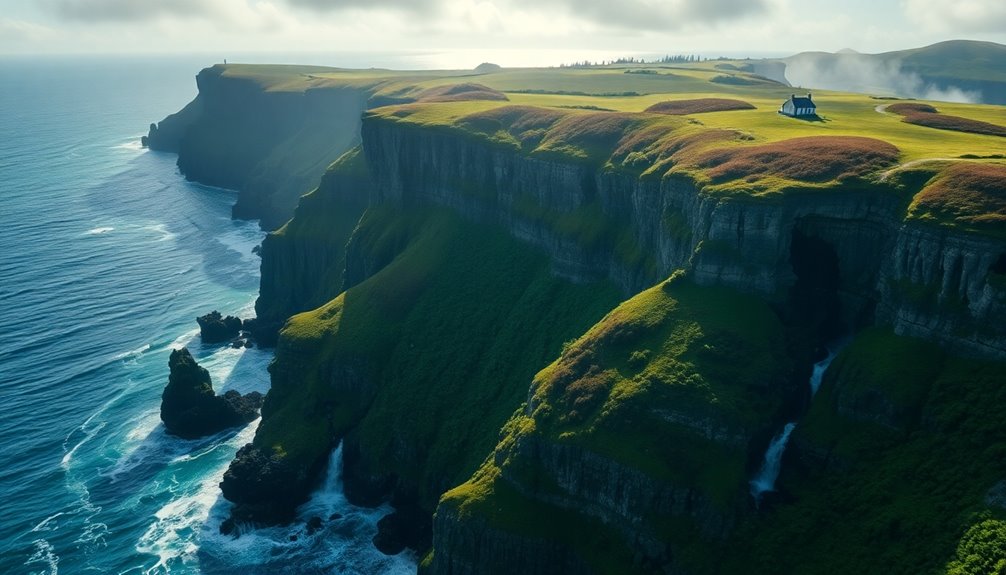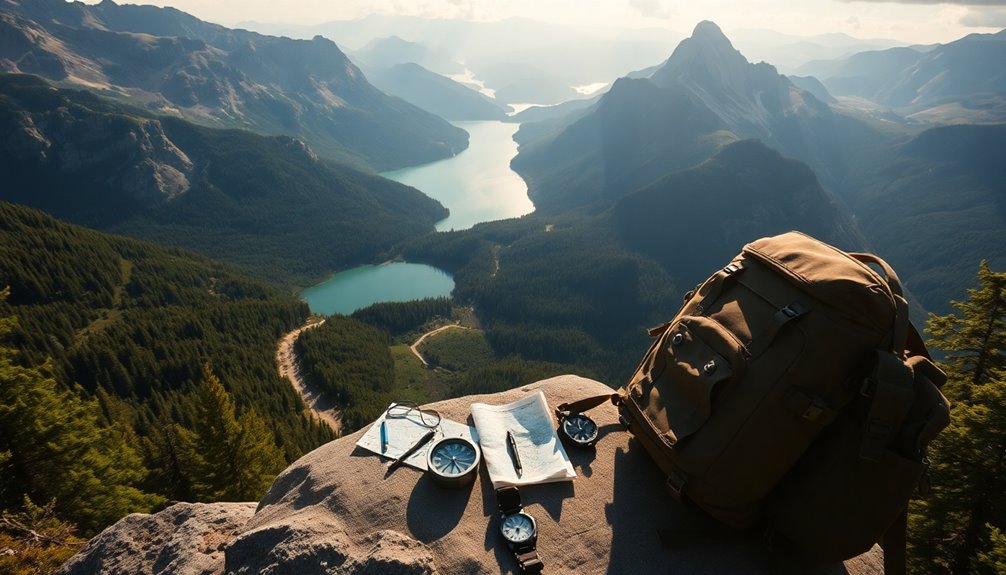When choosing a survival location, consider regions like the Appalachian Mountains for their biodiversity and water sources. You'll find the remote wilderness of the Irish Nephin Beg Range that offers seclusion and natural resources. The Russian Taiga, despite its harsh climate, is rich in food and shelter. Island nations like New Zealand and Iceland benefit from low population density and renewable energy infrastructure. Guarantee you prioritize access to clean water and plan for emergency needs. Each choice brings unique advantages, setting you up for success. There's much more to explore about these intriguing options and their benefits.
Key Takeaways
- Forested Areas: Choose regions like the Appalachian Mountains for their rich biodiversity, abundant water sources, and significant carbon storage capabilities.
- Remote Wilderness: Seek solitude in untouched locations like the Nephin Beg Range in Ireland or the Russian Taiga for ample food and water resources.
- Island Nations: Consider countries like New Zealand and Iceland for their low population density and established renewable energy infrastructure promoting sustainable living.
- Unique Natural Features: Explore biodiverse areas such as the Valdivian Rainforest in Chile, which offers stable temperatures and ecosystems essential for survival.
- Infrastructure and Renewable Energy: Prioritize regions with strong survival infrastructure and renewable energy options, enhancing sustainability and safety in challenging environments.
Ideal Geographic Locations

Choosing the right geographic location can greatly enhance your chances of survival in a crisis. Consider forested and remote areas like the Appalachian Mountains, where you'll find a rich variety of species and abundant water sources. If you value seclusion, the Nephin Beg Range in Ireland offers untouched wilderness. The Russian Taiga, though harsh, provides ample food and water, while the Valdivian Rainforest in Chile boasts high biodiversity without extreme temperatures. Notably, the presence of edible wild plants in these regions is crucial for sustaining yourself over time.
Island nations like New Zealand and Iceland present unique advantages. New Zealand's cooler climate and low population density make it a refuge far from major refugee routes. Iceland's robust renewable energy infrastructure guarantees resilience against climate change. Australia, with its diverse climates, offers high agricultural biodiversity, and Tasmania can serve as a potential lifeboat.
Mountainous regions are also wise choices. Lesotho's lush vegetation and water sources provide excellent resources, while Cheyenne Mountain in Colorado offers military-grade protection. Alaska's national parks are teeming with wildlife, and Tasmania's renewable energy initiatives support sustainable living. Whether you seek natural resources or shelter, choosing the right geographic location is essential for your survival strategy.
Climate and Environmental Factors

When considering survival choices, access to reliable water sources can make or break your chances. A temperate climate offers a balance that supports diverse ecosystems, which are essential for sustenance and stability. Understanding these factors can help you make informed decisions about where to thrive in a changing world. Moreover, species that possess physiological mating capabilities are more likely to adapt and survive in new environments influenced by climate change. Additionally, maintaining emotional resilience is crucial for navigating the challenges of survival in unpredictable conditions. The use of renewable energy sources can also provide sustainable power for essential resources in such environments. Furthermore, implementing energy-efficient technologies can help reduce reliance on nonrenewable resources.
Importance of Water Sources
Access to clean water sources is essential for survival, especially in challenging climates and environments. Dirty water leads to numerous health issues, causing approximately 3,575,000 deaths annually from water-borne diseases like cholera and dysentery. If you're in a survival situation, prioritizing clean water is non-negotiable. Without it, dehydration can impair your cognitive functions, making problem-solving difficult. Furthermore, access to clean water supports overall community health and reduces the risk of illness, which is crucial even in survival scenarios.
Look for natural bodies of water like streams and rivers, but remember that they often require purification. Stagnant water from lakes or ponds can harbor harmful bacteria, so it's vital to treat it before consumption. You can also collect rainwater, melt snow or ice, and even gather condensation from plants if needed.
Be mindful of environmental indicators—richer vegetation often suggests nearby water sources, and walking downhill can help you find flowing water. Pollution from nearby industries or agricultural lands can degrade water quality, so always assess your surroundings. Understanding these factors will empower you to locate and purify water, ensuring you stay hydrated and healthy in your survival journey.
Benefits of Temperate Climate
There's something remarkable about temperate climates that makes them particularly advantageous for both humans and wildlife. These regions, with their moderate temperatures and four distinct seasons, create diverse environments that support rich biodiversity. The temperate forests, for instance, provide essential habitats for numerous species, ensuring genetic diversity and ecosystem resilience. They also play an important role in climate regulation by acting as natural carbon sinks. Additionally, mature oak trees in these forests can sequester up to 5 tonnes of carbon, contributing significantly to global carbon storage efforts.
For you, living in a temperate climate means enjoying plentiful agricultural opportunities. The warm summers and sufficient rainfall allow for successful farming, while the cold winters have minimal impact on production. Additionally, these climates are home to a large portion of the world's population, fostering vibrant cities and communities.
Beyond agriculture, temperate forests enhance your quality of life. They improve mental health, purify air and water, and prevent soil erosion. You can partake in outdoor activities like hiking and wildlife viewing, connecting with nature. Ultimately, the benefits of temperate climates extend far beyond their pleasant weather; they support ecological stability and provide necessary resources for both current and future generations. Choosing a temperate climate can greatly enhance your survival and well-being.
Natural Resources and Biodiversity

When you explore natural resources, you'll find that abundant wildlife and diverse plant life play vital roles in ecosystem health. These elements not only support biodiversity but also provide essential resources for food, medicine, and recreation. Understanding their importance can guide your choices in conserving the environment and promoting sustainability. Ecosystem stability is enhanced through diverse species presence, making it crucial to appreciate the interconnectedness of all living organisms. Furthermore, the preservation of biodiversity is essential for reducing anxiety in local communities, as healthy ecosystems provide spaces for recreation and relaxation. Additionally, the loss of biodiversity can disrupt nutrient cycling, which is essential for maintaining healthy ecosystems.
Abundant Wildlife Resources
Abundant wildlife resources play an essential role in maintaining the balance of ecosystems and supporting human life. When you seek survival options, consider the environments rich in wildlife, as they offer food, materials, and even companionship. Remote areas typically host a higher occurrence of diverse wildlife compared to disturbed landscapes, which can provide crucial resources for your survival. Biodiversity is essential for ecosystem health, ensuring that various species can thrive and contribute to the stability of their habitats.
| Wildlife Type | Preferred Environment | Notes |
|---|---|---|
| White-tailed Deer | Fragmented landscapes | High reproductive output; abundant food |
| Raccoons | Urban/suburban areas | Highly adaptable; scavengers |
| Squirrels | Urban/suburban areas | Common; easy to hunt/forage |
| Coyotes | Undisturbed natural areas | Natural predator; regulates populations |
| Birds (e.g., Robins) | Varied habitats | Pollinators; indicators of ecosystem health |
While urban areas may support adaptable species, human activities often lead to habitat fragmentation, affecting wildlife diversity negatively. Understanding these patterns can guide you in choosing locations rich in wildlife resources, ensuring your survival while highlighting the importance of conservation efforts to sustain these crucial ecosystems.
Diverse Plant Life
Diverse plant life forms the backbone of healthy ecosystems. When you explore areas rich in this diversity, you'll find greater stability and resilience against environmental changes. Diverse plant species are key to maintaining significant ecosystem functions like nutrient cycling and pollination, ensuring that forests can withstand diseases that target specific trees. They also prevent soil erosion and keep the soil fertile, which is essential for food production. Additionally, tropical regions are known to exhibit the highest biodiversity, showcasing the importance of protecting these areas. Furthermore, many plants, such as celery juice, are rich in nutrients that can support overall health and well-being, while chia seeds are known for their ability to promote digestive health due to their high fiber content.
Moreover, plants play an important role in regulating air and water quality. Their root systems help prevent flooding while filtering pollutants, making environments safer and healthier. When you venture into wetlands or forests, you're witnessing natural systems at work, supporting complex food webs and habitats for various wildlife. Montessori toys can also encourage children to explore and appreciate the natural world, fostering a deeper connection to biodiversity.
Diverse plant life also impacts your health directly. Many medicines originate from plants, including critical treatments for serious illnesses. Plus, a variety of plants offers nutritious food sources and contributes to developing resilient crops. Economically, supporting biodiversity can enhance local industries and tourism, further emphasizing the importance of preserving diverse plant life for survival and well-being.
Appalachian Mountains Advantages

The Appalachian Mountains' rich biodiversity and unique ecosystems make them a treasure trove for nature enthusiasts and researchers alike. With over 80,000 occurrences of rare species, this region boasts 64 high-priority bird species, along with iconic mammals like bobcats, black bears, and moose. You'll find one of the most diverse temperate rainforests here, where the vast array of tree species thrives, historically dominated by the American chestnut.
Additionally, the Appalachian Mountains play an essential role in climate resilience. They store 56% of the eastern U.S.'s above-ground carbon, helping to mitigate warming. The region also serves as a refuge from rising temperatures and extreme weather events. Early successional habitats here sequester carbon rapidly, enhancing overall ecosystem health. Furthermore, the Appalachians serve as a migration corridor for many bird species, highlighting their importance for wildlife connectivity.
Moreover, the Appalachian community is deeply rooted in history, with Indigenous Peoples living here for 16,000 years. Today, 22 million people rely on its natural resources, with organizations working tirelessly to conserve these ecosystems. However, challenges like urban development and climate change threaten this paradise. By understanding its advantages, you can appreciate why the Appalachian Mountains are a significant choice for survival and sustainability.
Remote Seclusion in Ireland

If you're seeking untouched natural beauty, Ireland offers stunning landscapes that can easily draw you in. The ideal climate conditions, especially in remote areas like the Nephin Beg Range or Doolough Valley, provide a serene backdrop for solitude. Here, you can truly escape the hustle and bustle while immersing yourself in nature's splendor. To ensure a responsible experience, always seek permission from landowners when considering wild camping in these breathtaking locations.
Untouched Natural Beauty
Ireland's remote peninsulas and pristine coastlines offer a breathtaking escape into untouched natural beauty, where you can immerse yourself in the serenity of wild landscapes. Here, you'll discover secluded spots that feel worlds away from modern life. Picture yourself wandering through these stunning locales:
- The Beara Peninsula, with wild mountains and crystal-clear lakes, invites you to explore its winding coastal roads.
- Achill Island's Keem Bay captivates you with its calm, sandy beach backed by dramatic waterfalls and lush forested slopes.
- The Skellig Islands, rich in ancient history, host unique birdlife and offer breathtaking views of rugged cliffs.
These landscapes aren't just picturesque; they're also rich in biodiversity and tranquility. You can hike through the untouched bogs of Ballycroy National Park or admire the limestone karst formations in Burren National Park. The region is also home to secluded beaches and dramatic cliffs, making it a paradise for adventure seekers. As you venture through Ireland's hidden gems, you'll find not just natural beauty, but also a profound sense of peace. Embrace the remote seclusion and let these wild spaces rejuvenate your spirit.
Ideal Climate Conditions
Experiencing the ideal climate conditions in Ireland enhances your remote seclusion, making it an inviting destination for nature lovers. With a mild temperate oceanic climate shaped by the Atlantic Ocean, you'll find mean annual temperatures between 9°C and 10°C, perfect for enjoying the great outdoors. Summers are warm and pleasant, peaking in July with averages around 19°C, while spring offers rejuvenating temperatures of 8-12°C. Additionally, Ireland's climate zones are classified using the Köppen-Geiger system, providing a comprehensive understanding of the region's diverse weather patterns.
However, be prepared for significant rainfall, as Ireland experiences an average of 11 rainy days in March and April. The varied rainfall patterns across rural areas can influence your outdoor plans, especially along the coast, where consistent precipitation is common. Climate change has led to rising temperatures and increased rainfall, which may affect local ecosystems and agriculture.
Despite these changes, the mild climate remains a draw for those seeking solitude and natural beauty. The lush greenery and vibrant landscapes thrive in this environment, offering a serene backdrop for reflection and exploration. In choosing remote seclusion in Ireland, you embrace a climate that invites both adventure and tranquility.
Survival in Alaska

Surviving in Alaska demands a keen understanding of the harsh environment and the resources it offers. You'll need to prioritize shelter, water, and fire to stay alive in this unforgiving landscape.
- Construct a sturdy leaf hut or wicki-up using branches and grass for protection against the elements.
- Locate a nearby stream or lake for fresh water, and remember to purify it through boiling or filtration.
- Master firecraft, ensuring you can start a fire even in wet conditions using waterproof matches and dry tinder. Fire provides warmth and serves as a crucial element for cooking and signaling for help.
After securing shelter, focus on finding a reliable water source, as hydration is essential. Use metal coffee cans to heat water and cook food. Fire not only keeps you warm but also serves as a signal for rescue. Building a signal fire or creating an SOS sign can make a significant difference in your chances of survival.
Equip yourself with navigation tools like a map, compass, and GPS to help you find your way. With the right preparation and knowledge, you can navigate Alaska's wilderness and increase your chances of survival.
Resilience of the Russian Taiga

The Russian Taiga's resilience is a proof of nature's ability to adapt and thrive in extreme conditions. Stretching across an area comparable to the size of the United States, this vast forest tackles frigid winters, where temperatures can plummet to -50°C (-58°F), and brief summers that only last 50 to 100 days. The Taiga's coniferous trees, like spruce and larch, are perfectly suited for these harsh climates, using needle-like leaves and conical shapes to manage heavy snowfalls. Additionally, the Taiga covers approximately 29% of the world's forest area, making it a crucial component of global carbon storage.
Fauna in the Taiga has adapted remarkably, too. Large mammals, such as bears and moose, find ways to survive through hibernation or dietary flexibility, while smaller creatures like lynx and snowshoe hares have thick fur and seasonal camouflage. However, human impact—like forest fires and logging—challenges this delicate balance. While fires can rejuvenate the forest, they also threaten habitats and the livelihoods of indigenous peoples, such as the Evenki, who rely on this ecosystem. Conservation efforts are essential, as the Taiga not only supports diverse wildlife but also holds 50% of the world's soil carbon, making its preservation critical for combating climate change.
Infrastructure for Safety

When disasters strike, having a well-prepared infrastructure for safety can make all the difference. You need to guarantee you’re equipped with essential supplies and plans to protect yourself and your loved ones. Here’s what to focus on: In times of disaster, it’s crucial to have an emergency kit with food, water, first aid supplies, and important documents. It’s also important to have a communication plan in place with your family or roommates to ensure everyone is accounted for. Additionally, it’s a good idea to familiarize yourself with your community’s emergency shelters and FEMA pods in case you need to evacuate. Being prepared can make all the difference in the event of a disaster.
- Emergency Shelter: Keep tents, tarps, and insulated sleeping bags ready for immediate use.
- Communication Tools: Invest in battery-powered radios and local maps to stay informed and navigate effectively.
- Sanitation Supplies: Stock up on disinfectants, toilet paper, and bucket commodes for hygiene needs.
By prioritizing these elements, you'll create a solid foundation for safety during emergencies. Make certain to store enough water—at least one gallon per person per day for three days—along with non-perishable food items. A well-stocked first aid kit is vital too, so include bandages, medications, and basic medical equipment. Additionally, be aware that infrastructure breakdowns can lead to contamination of your water supply, making it crucial to have purification methods on hand.
Additionally, think about security measures for your home. Reinforcing entry points and having personal safety items on hand can provide peace of mind. Remember, it's not just about surviving; it's about thriving in challenging times. You're building resilience, guaranteeing safety, and preparing for whatever comes your way.
Renewable Energy Options

Preparedness in the face of disasters extends beyond immediate safety measures; it also includes sustainable energy solutions that can power your survival efforts. Exploring renewable energy options can greatly enhance your resilience. Here's a quick comparison of the most viable sources:
| Energy Source | Key Benefits |
|---|---|
| Solar Energy | Abundant, clean, cost-effective, versatile |
| Wind Energy | Renewable, low emissions, high utilization |
| Biomass Energy | Widespread use, traditional source, generates heat and fuel |
| Hydrothermal Energy | Earth's core heat, effective for heating/cooling, renewable but limited |
Solar energy shines as the most abundant resource available, even when skies are cloudy. It's clean, cost-effective, and perfect for various applications. Proper installation ensures longevity and efficiency of solar systems, and with excess solar energy that can be stored for nighttime use, it provides disaster resilience for communities. Wind energy, another strong contender, harnesses nature's power without contributing to greenhouse gas emissions. Biomass fuel, derived from plant materials, has been utilized for generations and can effectively generate electricity. Finally, while hydrothermal energy is renewable, its availability is limited to specific sites. By embracing these options, you'll not only enhance your survival but also contribute to a sustainable future.
Research-Based Survival Recommendations

Incorporating research-based survival recommendations into your routine can greatly enhance your resilience and well-being, especially for cancer survivors. Following the AICR's guidelines can profoundly lower your risk of dying and improve your quality of life. Here are some key recommendations you should consider:
- Stay Active: Engage in regular physical activity to boost your cardiovascular health and overall survival. Research shows that high adherence to AICR Recommendations results in half the risk of dying from colorectal cancer. Studies have also suggested that early detection of breast cancer symptoms can significantly improve survival rates. Additionally, maintaining a consistent exercise routine can also help in managing persistent pain associated with treatment. Regular exercise can also improve your sleep quality, promoting better recovery and overall health, as newborns benefit from consistent sleep patterns.
- Eat Right: Fill your plate with colorful fruits, vibrant vegetables, and wholesome whole grains while cutting back on sugary drinks.
- Monitor Your Health: Regularly check in on your physical and mental well-being to track improvements and adjust your lifestyle.
Colorectal cancer survivors adhering closely to these recommendations have seen a 37% lower risk of dying from any cause. Breast cancer survivors report less fatigue and better cognitive functioning by following similar guidelines. By making these small yet impactful changes, you not only enhance your survival rates but also elevate your quality of life. Embracing these research-backed strategies can empower you to take control of your health journey.
Frequently Asked Questions
What Are the Best Survival Skills to Learn Before Relocating?
Before relocating, you should focus on essential survival skills. Start with navigation skills—learn to read maps and use a compass. Master shelter construction, ensuring you can find or build safe places to stay. Get comfortable sourcing and purifying water, and know how to identify edible plants. Finally, familiarize yourself with basic first aid techniques to handle emergencies. These skills will prepare you for unforeseen challenges in your new environment.
How Can I Prepare Mentally for a Survival Situation?
Think of your mind as a garden; it needs nurturing to thrive. To prepare mentally for a survival situation, cultivate a positive attitude. Practice relaxation techniques like meditation to keep your thoughts centered. Train yourself to view challenges as stepping stones rather than obstacles. Each small skill you master acts like a sturdy root, grounding you in tough times. Trust your instincts, and remember, your mindset can be your strongest ally in adversity.
What Types of Gear Are Essential for Wilderness Survival?
For wilderness survival, you need essential gear that covers shelter, hydration, fire, and food. A durable tent or tarp will protect you from the elements, while a water container and purification system guarantee you stay hydrated. Bring a fire starter to maintain warmth and cook food. Pack emergency food supplies, a multi-tool, and signaling devices like a whistle and mirror for emergencies. These items will enhance your chances of survival in the wild.
How Do I Identify Edible Plants in the Wild?
To identify edible plants in the wild, you'll want to observe, document, and learn. Use regional field guides and apps like PlantSnap for precise identification. Note leaf shape, arrangement, and distinctive features like flowers and fruits. Establish a study area and track plants through seasons. Always verify you're 100% certain before consuming anything, and perform the universal edibility test when in doubt to avoid toxic look-alikes. Stay safe and informed!
What First Aid Supplies Should I Have on Hand?
You should have vital first aid supplies ready for minor injuries and emergencies. Stock adhesive bandages in various sizes, gauze pads, and adhesive tape. Include antibacterial ointment, antiseptic wipes, and hydrocortisone for infection prevention. Don't forget over-the-counter pain relievers like ibuprofen or acetaminophen. Tweezers and scissors are essential tools, along with gloves and a thermometer. Having these items guarantees you're prepared to handle injuries effectively when they arise.
Conclusion
As you weigh your options, remember that the right choices can mean the difference between thriving and merely surviving. Imagine standing amidst the Appalachian Mountains, or tucked away in the serene Irish countryside, where nature's bounty supports you. But don't overlook the resilience found in the Russian Taiga. The clock's ticking, and the world's shifting—choose wisely. Your next move could secure your future or leave you vulnerable. What will it be? The stakes have never been higher.










